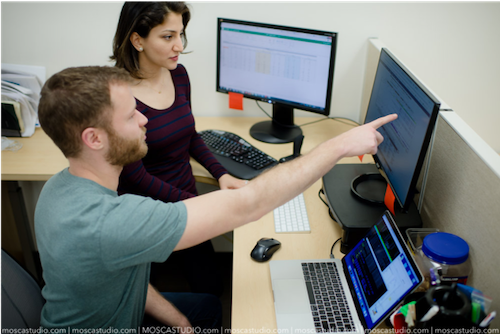Services
Let's make a plan

Gathering pilot data? Planning a study for a grant or a manuscript? Fill out the project inquiry form and email it to us here
Pre-award Consulting
We are available to help investigators planning for grants involving epigenetics research. As part of our pre-award consulting and support we will provide:
- Revision of the study design
- Letter of support
- Budget
- Partial FTE from computational biologist available
- Description of experimental and computational methods
In order to receive the best support please reach out at least 3 weeks before the grant deadline by emailing us here
Study Design & Sample Preparation
In order to maximize chance of success and rigor, each study needs to be carefully designed. For this reason, we ask investigators to meet with us at the very beginning of their study so that we can discuss:
- Experimental assay selection. We help selecting the appropriate assay(s) based on the investigator’s questions and budget.
- Number of samples and experimental groups. The size of your study will depend on different factors, but we generally discourage groups smaller than n=4 when possible.
- Sequencing strategy. This includes estimating the adequate coverage, read length, and instrument. We work in close collaboration with the MPSSR for sequencing.
- Sample preparation and submission. High quality samples are key for successful experiments. Please, see our requirements for sample submission.
We offer bioinformatics analysis of next-generation sequencing (NGS) data so that projects can be done end-to-end. After submitting the NGS libraries to the sequencing core, we monitor as they move through their pipeline. When ready, we download the sequences (fastq files) and start our analyses with established computational pipelines. Note that although we download the raw sequencing data to our server for analysis, clients will also need a plan to download and store the sequencing data for long term storage (such as on a hard drive or through ACC’s Research Data Storage). Larger projects may require additional coordination in order for us to access the data.
Assays offered:

- RRBS
- WGBS
- Low-input WGBS
- ATAC-seq
- ChIP-seq
- RNA-seq
- scRNAseq (limited availability, please see FAQs)
- Hi-C
Data QC & Standard Analyses
Our standard analysis includes quality assessment of the sequencing data received from the investigator or the sequencing core and generation of summary statistics (i.e. raw and filtered read counts, alignment rates). Depending on project needs, we may also perform data exploration techniques, such as principal component analysis (PCA) and clustering, and differential analysis. Besides the result files, we will provide a detailed report describing each step of the data QC and analysis.
In addition to custom pipelines, software we commonly use include:
- MultiQC
- DESeq2
- EdgeR
- Limma
- DiffBind
- MethylKit
- BSseq
- Seurat
Custom Analysis
Some projects are more complex than others and require the development of unique bioinformatics pipelines. If you have a project that deviates from the standard analysis, we will work with you to determine an efficient and cost-effective approach.
FAQ
-
What is a typical turnaround time for bioinformatics analysis?
The turnaround time for the bioinformatics analysis varies greatly depending on the nature of your data, the study design, analysis requested, and our queue. We should be able to provide a rough estimate once the project is underway.
-
What data is provided to clients following bioinformatics analysis, and how?
The exact results provided depend on the analysis requested. Standard analyses often include QC plots, data exploration plots, and differential analysis excel files. Once the analyses are completed, we upload the results and the analysis report to OneDrive. We send the investigator the link to this data so that they can easily access their data. Note: the investigator is responsible for downloading, storing and backing-up the raw data generated for their project as we will delete them soon after completion of our analysis. Please contact the OHSU Advance Computing Center (ACC) to inquire about storing options.
-
What skills/software are required to handle the results?
Proficiency in Microsoft Excel is crucial for exploring the results summary tables. Familiarity with the UCSC genome browser and the IGV data visualization tool is extremely helpful in exploring the epigenetic and genetic landscape of regions of interest. Tutorials for these browsers are available online, but we can provide some guidance.
-
What kind of sequencing should I do?
Our assays are based on Illumina sequencing. The specific platform, read length, and coverage need will depend on the study, and will be determined by our team.
-
How can I determine if my project requires a standard or custom analysis?
Most projects can be analyzed using our established computational pipelines. However, some projects might require custom analysis to address complexities in the data or hypothesis. We will be in constant communication with the investigator in order to find the most cost-efficient, yet rigorous, approach.
-
Do you analyze single-cell datasets?
We have experience analyzing single-cell RNA-seq data. However, as these projects tend to require more time and last longer, we can only support a limited number of these projects at a time and depending on our availability. Please, inquire and we can discuss options.
Chromatin Analysis
Chromatin is made of a combination of proteins (histones) and DNA. Chromatin structure is shaped by histone modifications and transcription factors and influences gene expression. The assays below are used to study chromatin structure.
Hi-C (chromatin conformation capture)
Hi-C sequencing is a type of chromosome conformation capture that allows an examination of chromatin organization in the cell. This technique allows investigation of long-range genomic interactions, such as the ones between promotors and enhancers. Hi-C data processing yields genomic compartments and topologically associated domains (TADs), informing which genes might be co-regulated.
For Hi-C applications, see here: https://arimagenomics.com/publications

An example heatmap produced from Hi-C data. The boxed region contains the NRXN1 gene on Hunman Chromosome 2.
Color density in the plot is proportional to contact counts observed between two genetic loci. This means that darker regions reflect an increase in interaction between two points on the plot's center line.
DNA Methylation Analysis
DNA methylation is a chemical modification of the DNA by which methyl groups are added to the DNA molecule. In mammals, methylation is added to CpG sites. DNA methylation changes the activity of genes or regulatory elements, without changing the sequence. We offer different types of DNA methylation profiling, all based on next-generation sequencing. A description of these methods and how they compare with each other is provided below
Whole-genome bisulfite sequencing (WGBS)
Whole-genome bisulfite sequencing (WGBS) allows for base-pair resolution quantification of DNA methylation across the whole genome. Although this method is considered the gold standard, it is also the most expensive as high-coverage sequencing is required across the whole genome. Advantages of WGBS include that it can be applied to all species and allows for lower DNA input requirements than RRBS (seen success with >=25 nanograms)
Low-Input WGBS
allows for base-pair resolution quantification of DNA methylation across the whole genome. Advantages of low input WGBS include that it can be applied to all species and has very low DNA input requirements (10pg-100ng). Projects can also start from a small number of cells rather than extracted DNA.
Reduce Representation Bisulfite Sequencing (RRBS)
Reduce Representation Bisulfite Sequencing (RRBS) uses digestion with the restriction enzyme MspI to analyze a portion of the genome where DNA methylation occurs (i.e. promoters, CpG island, CpG shores). This approach still generates a genome-wide map of DNA methylation but the sequencing costs are substantially lower than WGBS. This approach can be used in all species and requires >100 nanograms of high-quality genomic DNA (see sample submission).

This section is currently under construction.